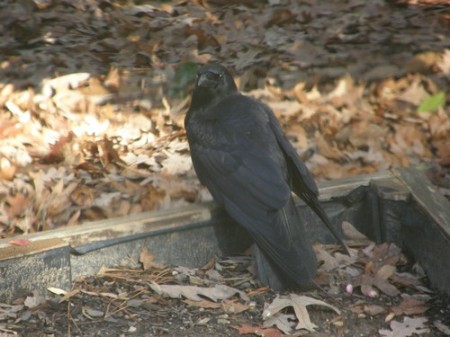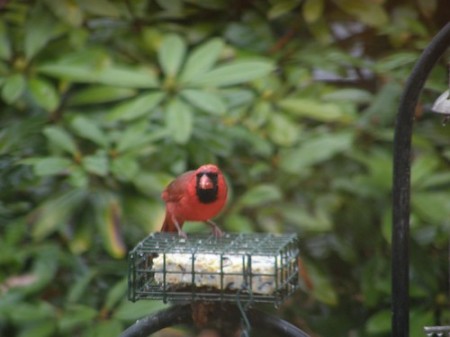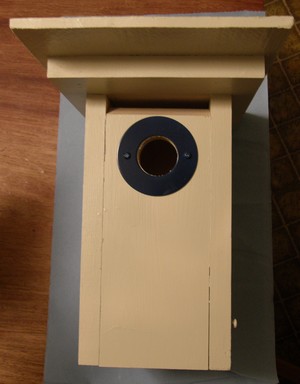This article discusses an Eastern Bluebird nestbox that is an ideal building project for individuals as well as groups . It can easily be turned into a kit for assembly during workshops or as a school science project.
Suitable materials for building nestboxes can often be obtained from the scrap piles located near new home construction sites. Be sure to ask the job site supervisor for permission to remove the scrap materials. AVOID using pressure treated lumber due to its potential to harm woodworkers and birds.
Nestbox building materials for school science projects, bird trails, scout projects, etc. can often be obtained through grants. Home building supply companies including Lowe’s and Home Depot budget money annually for such grants. Be sure to submit your request early in the budget year along with a project description. Be prepared to talk to your local store manager about the project. A well prepared project plan can be a great help in securing grants.
Before starting a bluebird nestbox building effort be sure to review the specifications for bluebird nestboxes. Click on the link below to review specifications.
North American Bluebird Society nestbox specifications
Let’s start the discussion by examining a completed nestbox before it is painted or stained.

Photo #1 – Eastern Bluebird nestbox front view
With the exception of the roof, the nestbox is made of 1 X 6 white pine board. The nestbox shown in Photo #1 is a flat-roof front-opening type equipped with a metal locking pin located on the lower right side.
The double-roof consists of a 1 X 8 white pine board inner roof covered by a 12” long piece of James Hardie cedar mill fiber cement siding that is 8 1/4” wide. The double roof provides an effective heat barrier to resist radiant energy absorption. Radiant energy absorption through roofs is responsible for much of the heating that takes place within nesting chambers on hot summer days. The fiber cement outer roof will increase the useful life of the nestbox by many years. The long roof overhang in front provides extra shelter from elements. This feature affords cover for the adult bluebirds during the feeding phase of the nesting cycle.
A 30–degree upward sloping vent is provided at the top of the door to create an “air scooping effect” when breezes are available. This feature increases air flow and helps to lower the temperature within the nesting chamber.
The 1 1/2” diameter entrance hole is covered by a circular plate steel protector. The hole protector prevents hole enlargement by woodpeckers and gnawing varmints. Enlarged entrance holes allow undesirable bird species such as Starlings to gain access to the nestbox.

Photo #2 – Eastern Bluebird nestbox side view
The nestbox features side roof line vents to improve ventilation and help prevent “heat pockets” from building up under the roof.

Photo #3 – Eastern Bluebird nestbox rear view
The nestbox also features a rear roof line vent to facilitate airflow through the nesting cavity. This feature is especially useful when breezes are available. The roof overhang at the rear of the nestbox shelters the roof line vent and helps protect the upper wood surfaces from the elements.

Photo #4 — Eastern Bluebird nestbox front view with door open
Easy access to bluebird nestboxes to allow monitoring and cleaning is a critical requirement. This nestbox is a front-opening-type hinged at the top and equipped with a metal locking pin located on the right side. The floor of the nestbox has been recessed 3/4” to prevent “drip siphoning” and provide a finger hold for opening the door. Drip siphoning occurs when water crosses the edges of the bottom surfaces and is absorbed by the floor. The floor has 45–degree corner cuts and a 3/8” diameter center drain hole to provide drainage if water should enter the nesting cavity.

Photo #5 – Eastern Bluebird nestbox after painting
The nestbox shown above was primed with Zinsser oil-based exterior primer. A “light sage” colored exterior paint was used as the finish coat on the nestbox. Lighter colors are desirable to help lower radiant energy absorption. The metal hole protector was painted royal blue to signify that nestbox is intended for bluebirds.
Note: Do not paint or stain the interior surfaces of the nestbox.

We need your help to survive!
Please help conserve our bluebird population by building safe comfortable durable nestboxes and locating them in suitable nesting areas.
A North American Bluebird Society membership will help in the bluebird conservation effort and also makes a great gift for family members and others. Click on the link provided below to order a membership or become a sponsor. You can also donate in memory of a loved one.
North American Bluebird Society membership
If you would like a copy of the plan and bill of materials for the nestbox, click on the link provided below.
Flat roof nestbox plans
Bluebird Shepherd
Help-for-Bluebirds.org




 Posted by helpforbluebirds
Posted by helpforbluebirds 

























